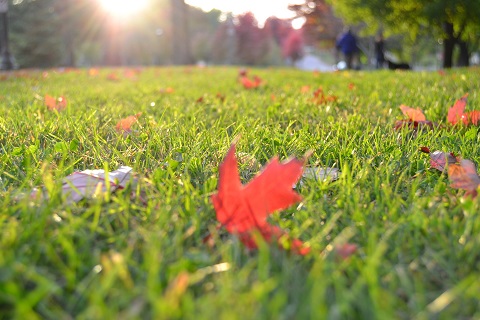Fall Lawn Care

1. Why is it necessary to remove leaves from your lawn?
First, while it can be a time-consuming job, make the effort to rake or remove leaves from your lawn. Leaves that are left on the lawn, especially maple or sycamore leaves, can actually smother the lawn, block light, and trap moisture, which will prove fatal to your grass when spring comes. Raking will not only keep your lawn in good shape, but it will also provide you with inexpensive mulch for your garden beds. Save the raked leaves and run over the leaf piles with a lawn mower. This will shred the leaves and keep them from matting. Liberally mulch your gardens, trees and shrubs after the ground has frozen. If you still have a lot of leaves, then be sure to compost the rest of them.
2. At what point in the year should you stop mowing the lawn?
Continue mowing as long as your grass is growing which is typically up until the first hard frost. Also, make sure you are cutting your grass to the right height. This height depends on what type of grass you have. The right height for your grass is important because grass that is too tall will mat and be vulnerable to fungi. However, if you cut your grass too short, it will reduce the root system, since root depth is proportional to cutting height. Most modern mowers also do a good job of mulching tree leaves if they aren’t too thick. Just leave the cuttings out on the lawn to decompose. This can help protect against sudden frost and also helps to feed the lawn.
3. How often should you aerate your soil?
Aerating your soil about every couple of years. Over time, soil becomes compacted and covered with thatch, which is a thick layer of roots, stems, and debris, which will block water, oxygen, and nutrients from reaching and feeding your soil. Aerating will punch holes in that layer and allow those nutrients to get to the roots. Additionally, aerating the soil right before you fertilize is a good idea because the fertilizer can get straight to the roots.
4. Should you fertilize your lawn in fall?
Another way to help your lawn is to fertilize it. Fertilizer will protect the roots from freezing and give grass the energy to bounce right back from winter once spring comes. Fall is greattime to fertilize because even after the grass leaves stop growing in late fall, the roots continue to grow and fall fertilization ensures that your lawn goes into winter in good condition, which in turn helps with early green-up the following spring. You can do a soil test that will tell you exactly what nutrients your soil needs. Make sure that when you fertilize, it is not applied near waterways in order to prevent contamination from runoff.
5. Should you patch your lawn in fall?
Early October is a good time for overseeding or patching the lawn. A thick lawn is great protection against weeds. Fall is the perfect time to spread grass seed because the soil's still warm, moisture is abundant, nighttime is cool, and the sun isn't as hot during the day. Make sure seeding patches are carefully watered and keep foot traffic away from the area.
